ATW90. Bhutan Part 2. Thimpu
This is the fourth in a series of posts I am making, which will be extended to create a book, Around the World in 90 Minutes.
Please send any comments or inaccuracies to atw90@leohoenig.com
For future posts, where I am going, follow me on facebook.com, twitter @leohoenig and Instagram @hoenigleo
Sunday morning and I am heading north again, for most of the way to Thimpu, we follow the roads we had used to come down from Paro, with just a little diversion near the end. The scenery as you run back through the hills is just as spectacular as going the other way, and I certainly have not tired of it.
The fact that the journey takes over four hours, for a distance that we could easily cover on a good European motorway (i.e. not the M25) in 90 minutes in not lost on me. There is one official stop on route, at a restaurant overlooking a power project, and a couple of extras, so as I can take photos while the driver and guide enjoy cigarettes.

A large portion of the population of Bhutan are smokers, despite the fact that there are no shops that buy and sell tobacco. I would have been allowed to bring cigarettes in with me, but a high duty is payable. Yeshi (my guide) implied that in fact cigarettes are quite easy to obtain, but did not go into detail.
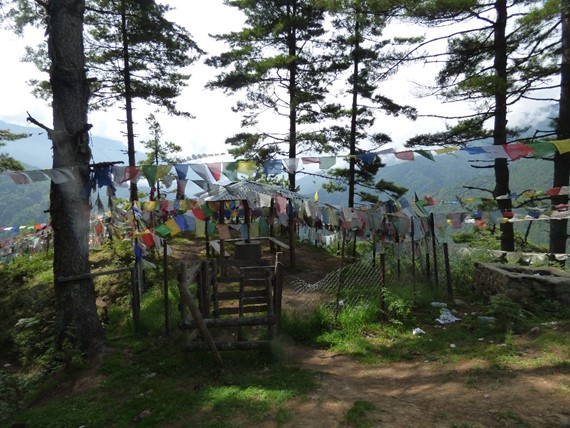
It is a chance to reflect on the other things that the road traveller enjoys in Bhutan. Prayer flags are everywhere, fluttering in the wind, which supposedly releases the prayers. Also prevalent are the small stupas (known as Tsa-tsa, or chortens) that look like stone fairy cakes. These gather in groups, sometimes in their hundreds as a spiritual offering. Each one is must be hand made and contains a prayer. You do not buy these in shops, but craft them yourself, chanting prayers as you mould them from the mud or clay.
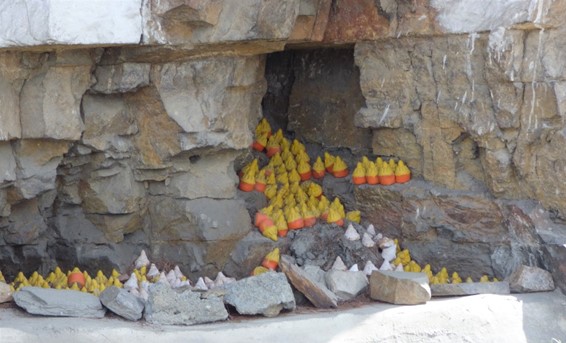


But if there is one thing that distinguishes the roadside in Bhutan, it is the road safety signs. Mainly pained on wooden, boards, but occasional painted direct onto cliff faces, the signs give safe driving advice, almost always in English, and often with a little humour in their rhyming couplets
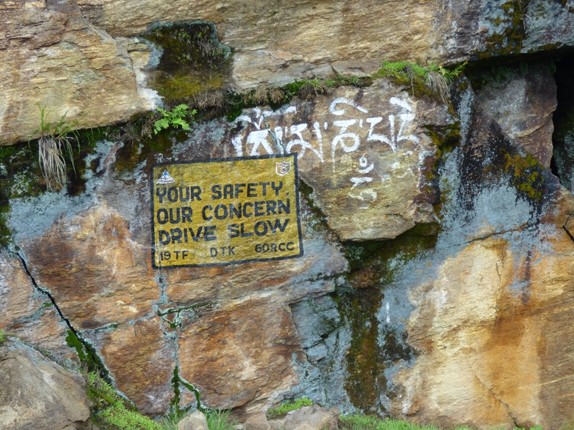
These amused me enough that I started recording them as I went
“For safe arriving, No liquor in driving”
“Speed is a knife, that cut’s life”
“Faster, will create disaster”
“Be Mr Late, Not Late Mr”
“After Whisky, Driving Risky”
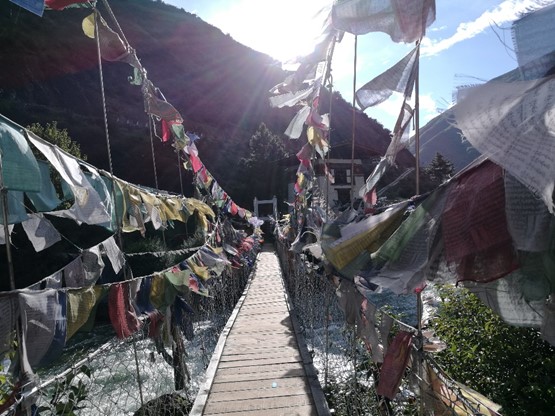
Arriving in the capital, I am taken to a hotel that is practically opposite the stadium. This allows me to worry as I relax as I can see the occasion movement of football down below me. Is the kick off time wrong? Have they started without me? Of course, the answer is no – it is explained to me the following day that since the artificial surface has replaced the rutted grass, there is no end of people trying to book the pitch, and it could easily be played on 24 hours a day, at least over the weekend if the Bhutan Football Federation would allow it.
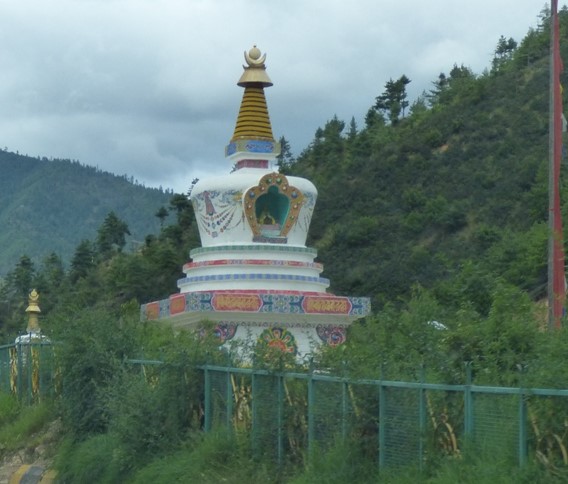

Changlimithang Stadium View from the hotel, with a Buddha standing behind, hopefully blessing the sportsmen and women of Bhutan
I do most of my sightseeing in the town the following day, and to be honest, it is not the most exciting of towns. There are a couple of interesting and colourful displays, and a very large Buddha overlooking it all. Not for the first time, I am told that I am looking at the world’s biggest, although as the Bhutanese are never one to overstress themselves, this statement is qualified that it was when created, and therefore there may be bigger, newer images.
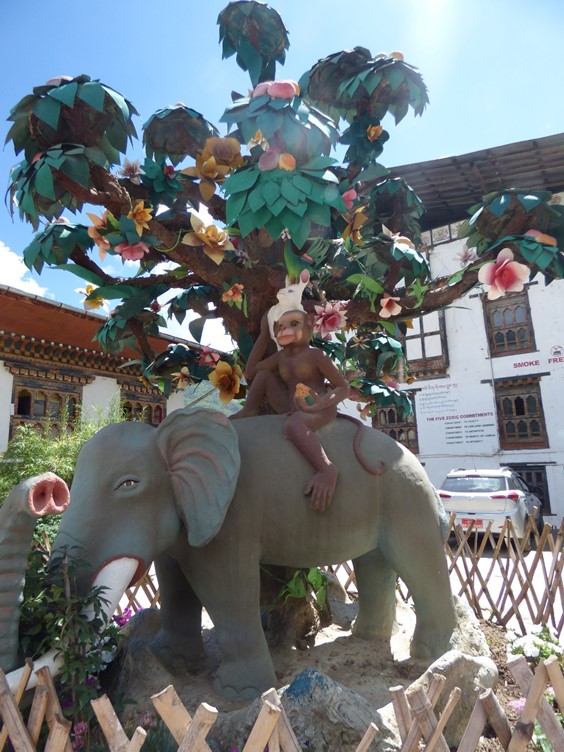
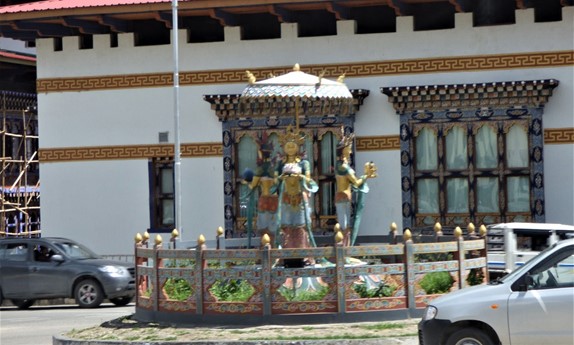
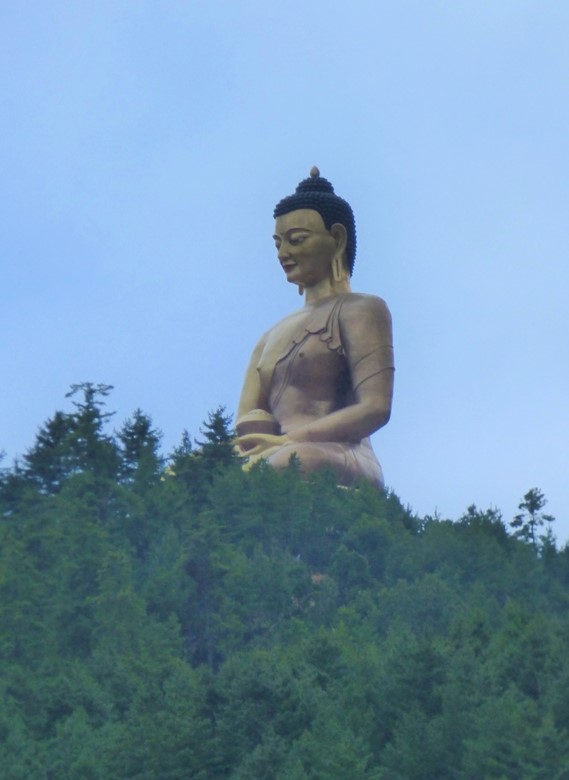
And so, to the Changlimithang stadium and the match, an evening kick-off, but with a little day light left when I enter the ground.
Most of the seating is on the side where you are entering, where vast banks of plastic bucket seats line the side. At one end, the seats curve round until they reach a line behind the goal. At the other end, there is a more unusual situation, where the line continues straight, although with less fitted seats on the concrete steps. It is possible for there to be a second (grass) pitch end to end with the main pitch, and before you reach the archery grounds further down this end. At the moment, this is not marked out. There is just a path behind the goal
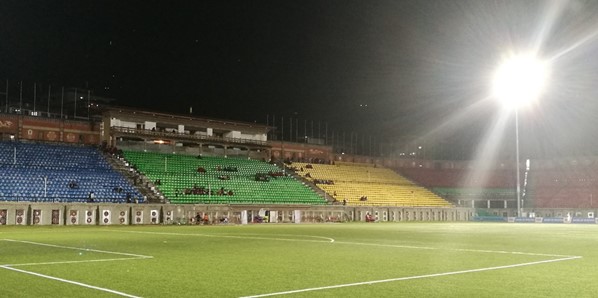
Opposite the main seating area is the grandstand, and this must go down as one of the most impressive stands in world football.

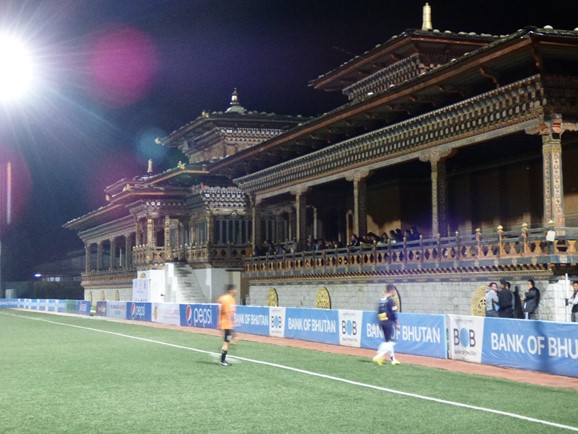
The seats in the main stand tend not to be fitted, and when I went over to this side for the second half, I got to sit on a “comfy” seat, with cushions. There are two large steps behind me, where I would imagine more seats could be brought out when the occasion demands. I sat on the right had side of the stand, with the left side being somewhat similar. The central section is the royal box, and hence was out of bounds, even with no VIPs at the game.
I estimated the crowd as just under 400, most of which stayed on the main side. At least a quarter of which were in monk’s robes. The monks however, in common with most of the crowd spent a large portion of their time consulting their smart phones.
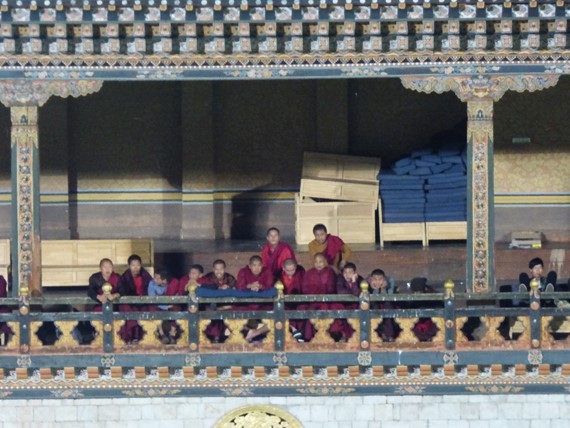
A group of monks watching intently, (unless they get a message on their phone)
At one stage, I recall the British press reporting on Bhutan allowing a limited amount of TV into the country. In fact, the first TV broadcast in the country, which was just to a screen in the main square of Thimpu was the 1998 World Cup Final. It was the success of this venture that prompted the allowance of TV the following year.
Despite fears that TV would impinge on the general way of life in the kingdom, and a review five years after it was started, the availability of TV has increased dramatically. There are now two national TV stations, but citizens also have access to Indian cable and satellite channels and can watch a smorgasbord of European football for just a few pounds a month.
The fears that this would change the way of life seem not to be realised, but the new revolution, the smart phone is having far more effect than TV ever will
Thimpu City, second placed in the league but needing Transport United to slip up twice in two games if they are to win the league, thanks to a rule that if points are equal, the league is settled by head to head, not goal difference. A club official said to me before the game that they regretted voting for that rule and might try to change it for 2018
The first half was expected, with City ending the session 2-0 in front. The first came after 15 minutes, when a long ball left the U-17 national player Nima Tshering in space to score with confidence. On 39 minutes, Longtok Dawa took a shot that squirmed under the visiting keeper for 2-0. 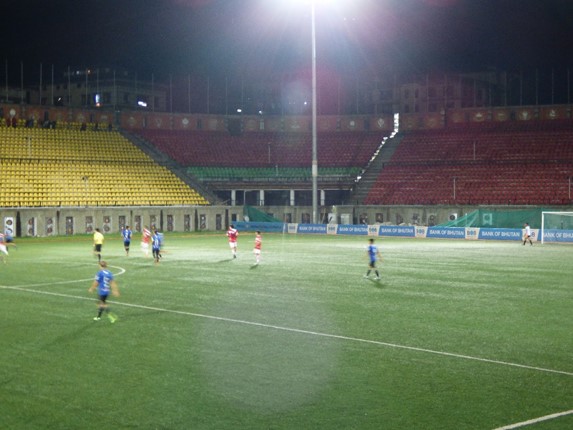
I was predicting more of the same for the second half and maybe a four goal difference at the end. I was wrong.
Chencho Gyeltschen had been pointed out to me as the star player, but his first half performance did not justify this. Still, just two minutes into the second period, he succeeded in getting behind the visiting defence and although his ball went straight to the keeper, it then bounced out so as Longtok Dawa could score again.
The door was now unlocked, especially as immediately after CG7 had scored the fourth in the 52nd minute (a simple header from a corner), Damash replaced the tiring Nima Tshering.
58 mins 5-0 (CG7).
63 mins 6-0 (Damish)
66 mins 7-0 (CG7)
71 mins 8-0 (Damish)
74 mins 9-0 (CG7)
75 mins 10-0 (Damish)
79 mins 11-0 (Damish)
80 mins 12-0 (CG7)
85 mins 13-0 (Longtok Dawa)
So five for Chercho Gyeltshen, four for Damish, three for Dawa and one for Nima.
I commented to Yeshi that the difference was that in the first half, Thimpu City were employing a very direct approach to the game, and attacking in the middle of the park. After the break, the sought the spaces that were always available on the wings and got behind the defence.
Thimpu City had an Englishman, Vincent Deacon as player-coach. He was an unused substitute in this game. I spoke to him briefly at the end of the game. Asking him first how he came be a football coach in Bhutan, he gave me a brief synopsis.
“I played semi-professional football in England for a long time, I played for a professional club, Rushden and Diamonds – not starting – just trained in my youth” Which semi-professional team?
“Rushden and Higham, in the United Counties League. I played for University teams when I was at University. I had an injury, damaged knee ligaments and I gave up playing after that”
“So I hadn’t played for six or seven years, never thought football would come up again. One of my brothers had trials at Wigan and Peterborough. He still has his dream in America, but I thought mine was over”
Deacon is apparently one of three brothers, all of which were taken on by different football league teams, but all discarded at the line between youth football and professional contracts.
“I came to Bhutan as a teacher, I asked if there were any football leagues where I could just kick around, you know, nothing serious. I managed to get in touch with Yeshi*, who is, I guess the philanthropist in charge of all things football in Bhutan. I played for them last year in the National League and apparently, I did very well. So much so I was asked to stay on and become coach, and the rest is history. I was helping out as coach/player, then the first team coach went to Australia, and I was left in charge – and that’s the journey”
What do you think of Bhutan football overall? “Its good, there are some good technical players”
It seems there is a big gap between the better teams and the others, “Yes, there is a massive gulf, you have two teams competing and that’s it. But the first XI, Bhutan’s football is improving, just look at how the national team is moving up the rankings” “They are now beating teams like Sri Lanka and Bangladesh, which they could not do five years ago”
“If you look at the Under-15s traun, you’ll see even more progress. There are some good players coming through. So Bhutanese football is heading in the right direction. All coaches that come here will tell you the same thing though. They need to stop just listening and doing as they’re told and actually do some thinking. All the coaches, the German coach for the National tea, the Japanese one for the Under-17s and myself have all said “question the coaches, question what you are doing, be more inquisitive”. I think that is the biggest change in Bhutanese football, they are starting to think, what are we doing, where is the space, and looking over your shoulder.
“If you take ten looks before you receive the ball, you know where everyone is, you know where to pass the ball, and all of a sudden you have more time”
I ask about the league fixture structure. Despite having only ten rounds of the league season, it has been rather strung out. Seven games were played together, than we had the week I was there with round 8 at the weekend, round 9 in the following midweek – and finally round 10 is two weeks later
“Yes its strange, we play two games in a couple of days, and then have to wait two weeks for the next one” I ask if there is a reason as I didn’t understand this. “I don’t understand either, its something the coaches need to sort out at the meetings with the FA, its very hard for a coach to maintain continuity”
“The fixture list is something we should improve, and this should in turn help the players”
I said I thought they needed more matches overall
“I agree, maybe we can play each team three or four times. There is a Thimpu league, and then there is a national league, so the Thimpu teams have twice as many fixtures. This (the National League) is meant to be the showcase of Bhutanese football. This may not be true as the Thimpu league is more competitive”
“There is talk of putting Pheuntsholing into the B league in Thimpu” to give them more fixtures, which could be beneficial to them”
“There is another team in Punakha called Uygen Academy. All their games are very tight, they are still losing, but they lost by 1-0 to Transport, by one goal to us”
“When we played against Transport, it was a strange one. As a team we were unbeaten in quite a long while”. (City had finished ahead to Transport to win the Thimpu League), “We scored two early goals and everyone thought we were going to steamroller them, but we stopped playing, and then we lost that game. The problem we are seeing with the National League is we lose one game, and we’ve lost the league”. (The two had drawn in the opening game of the season, but the second meeting finished 6-3 to Transport – Transport finished with nine wins and a draw, City lost and drew with Transport and also dropped a point in the final game, when they were held by Uygen Academy).
“You have to say the team that won deserved it, but one game and losing the title, it’s hard to take”
For the record, Thimpu City only lost twice in 2017, playing 26 games. They won the Thimpu League with a record of 13 wins and a draw, they were second in the National League, 7 wins, two draws, one defeat and a two legged tie against Valencia (Maldives) in qualifying for the AFC Cup. They lost that 3-0, all goals in the second (away) leg.
After that, I took time to go to a microbrewery, fortuitously located in the next block to my hotel. The bar was not particularly busy, and I could watch something from the Premier League on TV. The beers were well worth it though.
The following day we went around the museum, which was quite interesting, if a little small. I got to fire an arrow using an old-style bow, rather than the modern behemoth. I managed to fly it over the compound wall, but fortunately did not cause injury
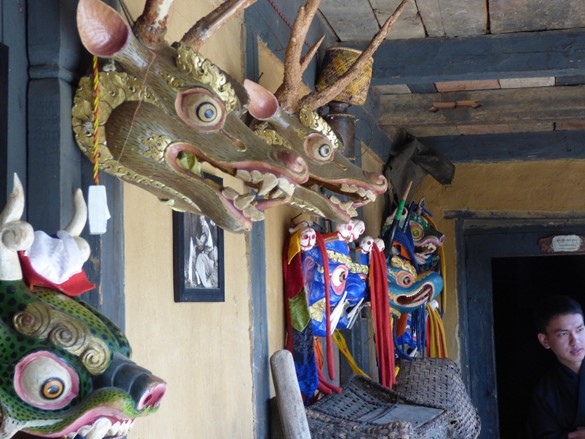
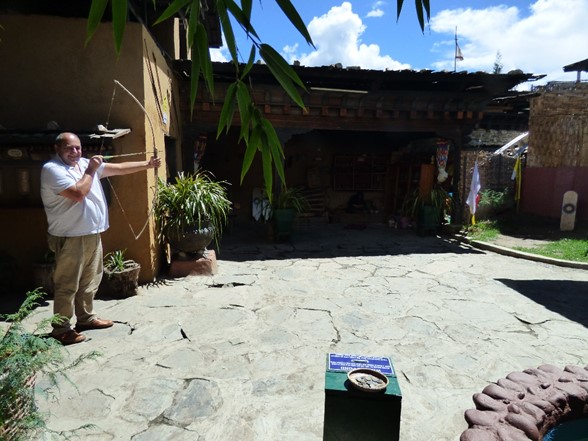
From there, it was onto a craft museum and then a visit to the Bhutan Football Federation, where I met with the general secretary, Ugyen Wangchuk and had a lengthy discussion about the game in Bhutan. Some of his comments have been used to inform the two blog articles, while the rest of the interview will add to the Bhutan section when “Around the World in 90 minutes” is published. It will be interesting to compare this with what is seen to happen over the next year or two.
The federation headquarters are at a training ground. Although this has an artificial surface, in common with the Changlimithang Stadium, it does not appear to get so much use. The ground appears good enough to stage some low level competitive football, but apparently this is rare
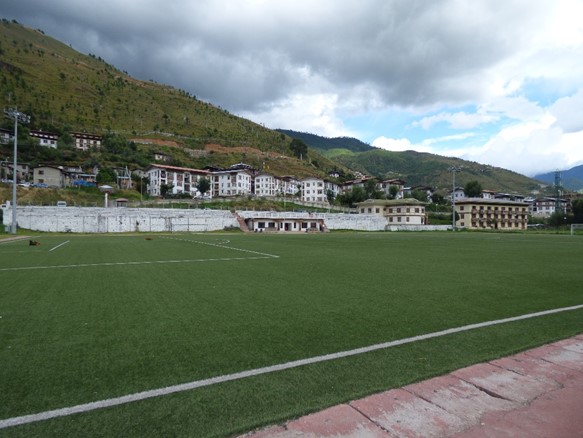
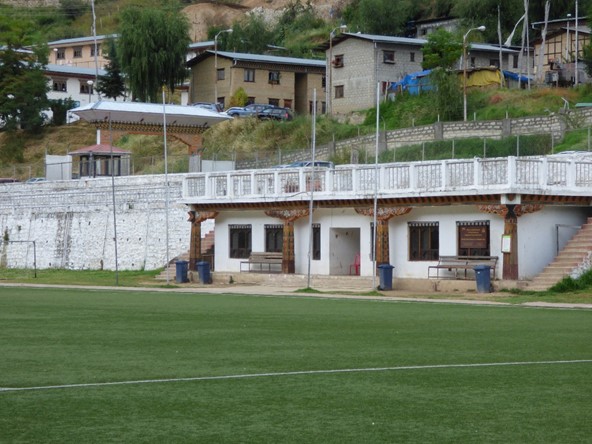
The ground has nicely raised spectator accommodation on one side, with the best above the changing room block
After that, we did return to Paro, once again following the scenic valleys, and stopping at the more interesting places for viewing and cigarettes
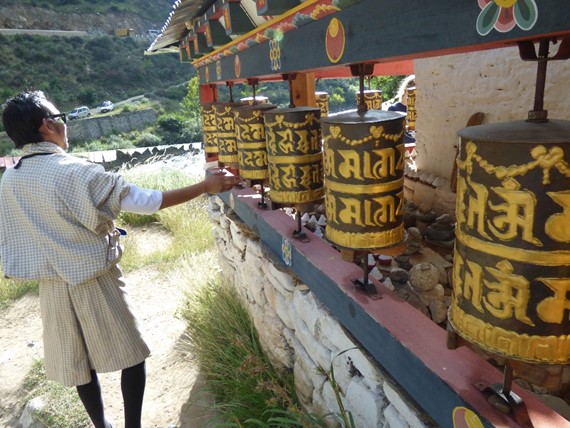
We also stopped at the ground Paro United use, some 5km out of town. One can see why they are desperate to build a new venue, (with artificial surface) closer to the town
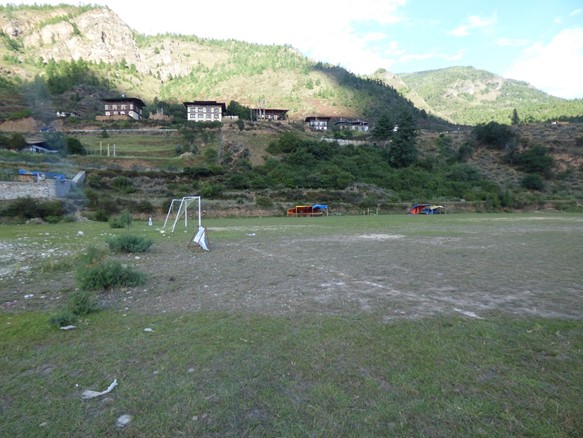
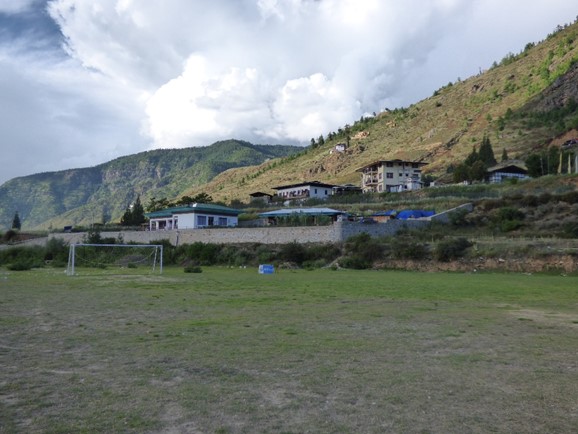
It is an impossible, rutted surface – yet two days after I took the photo, Paro played at home there. If I had one disappointment from the whole trip, it was that the Bhutan tourist taxes made it impossible for me to make a longer trip and possibly include Paro, or even Uygen.
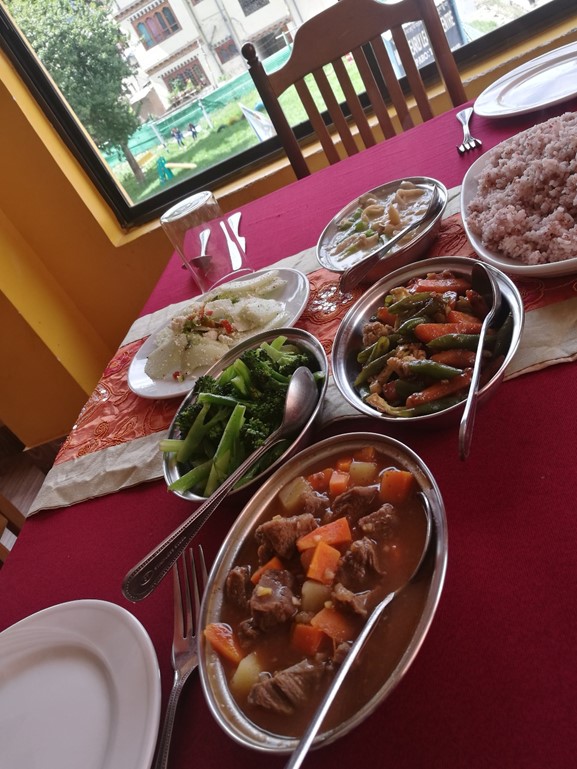
With all the meals included in the price, they made sure I ate well during the trip. Bhutan has its own distinctive cuisine, which is neither quite Indian, nor quite Chinese, but certainly quite worth trying
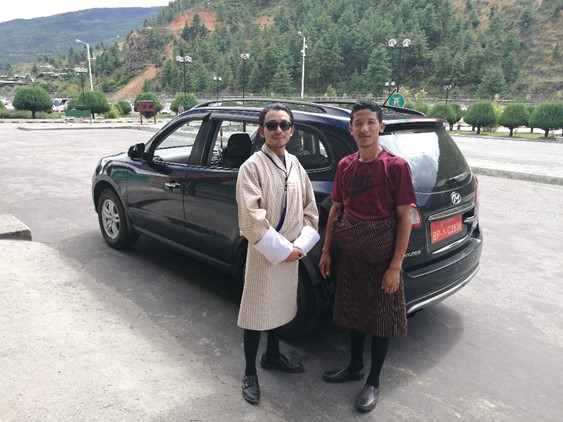
My guide and driver saying farewell at the airport. The traditional clothing that they wore throughout is seen throughout the country. It also appears to be compulsory as school uniforms.